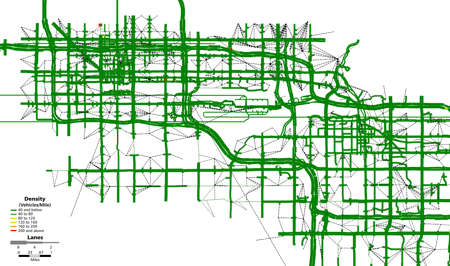 TransDNA Dynamic Traffic Assignment Software
TransDNA Dynamic Traffic Assignment SoftwareCaliper Corporation's TransDNA™ is a mesoscopic traffic simulation platform designed for performing dynamic traffic assignment (DTA) on large-scale, regional networks.
TransDNA is designed to run on regional planning datasets from TransCAD® or other planning software. TransDNA takes account of the geographic and geometric attributes of the planning network in the DTA, including roadway curvature, intersection geometry, and traffic signal timings that play crucial roles in determining interactions between time-varying travel demand and roadway capacities. Dynamic traffic simulation projects can thus be quickly created from existing static regional datasets, leaving the modeler to focus available resources on the critical tasks of traffic model calibration, validation and scenario analysis.
 TransDNA offers a high performance and vastly more accurate, as
well as convenient, professionally developed and supported
alternative to academic DTA software. As with other Caliper
software, TransDNA is multi-threaded and will achieve very fast run
times that are typically faster than real-time, enabling application
in real-time traffic management schemes.
TransDNA offers a high performance and vastly more accurate, as
well as convenient, professionally developed and supported
alternative to academic DTA software. As with other Caliper
software, TransDNA is multi-threaded and will achieve very fast run
times that are typically faster than real-time, enabling application
in real-time traffic management schemes.
TransDNA uses time-varying origin-destination (O-D) demand input and propagates vehicle trajectories based on a mesoscopic traffic simulation engine. The mesoscopic simulator uses speed-density relationships and roadway capacities to capture congestion effects, delays, and the formation and dissipation of queues and spillbacks. The link travel times from the mesoscopic simulation are used to compute dynamic equilibrium solutions that are consistent with the simulated drivers' time-varying route choice decisions. Network conditions are displayed in dynamic, color-coded maps, where users can choose the measure of performance to view (e.g. density, flow, or speed). Thus, the dynamic pattern of traffic flow can be observed and monitored by iteration as the DTA progresses without the need for post-processing.
The calibration of TransDNA involves the estimation of travel demand, network performance and model parameters to match measured traffic data. These quantities include time-varying O-D tables, route choice model parameters, congested link travel times, speed-density functions and capacities.
TransDNA works with TransCAD and relies upon TransCAD for supporting data management. TransDNA can replace a static equilibrium traffic assignment in a regional model and provide guidance for traffic and congestion management. It can also generate time-dependent dynamic congested skims for activity models.
TransDNA is compatible with TransModeler and can be used to help develop and calibrate wide-area traffic microsimulation models. For more information, please contact Caliper Sales at sales@caliper.com or (617) 527-4700.
Home | Products | Contact | Secure Store